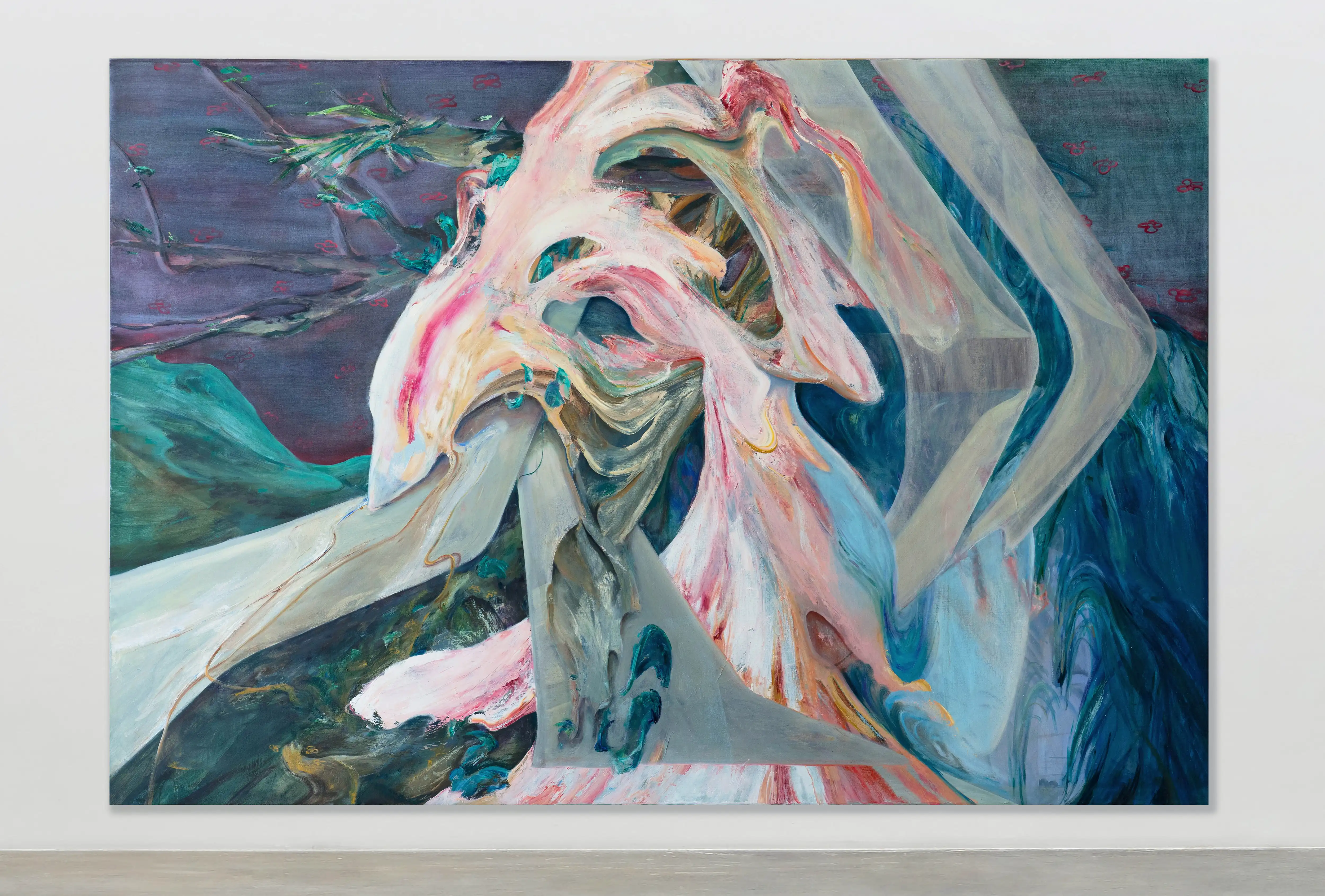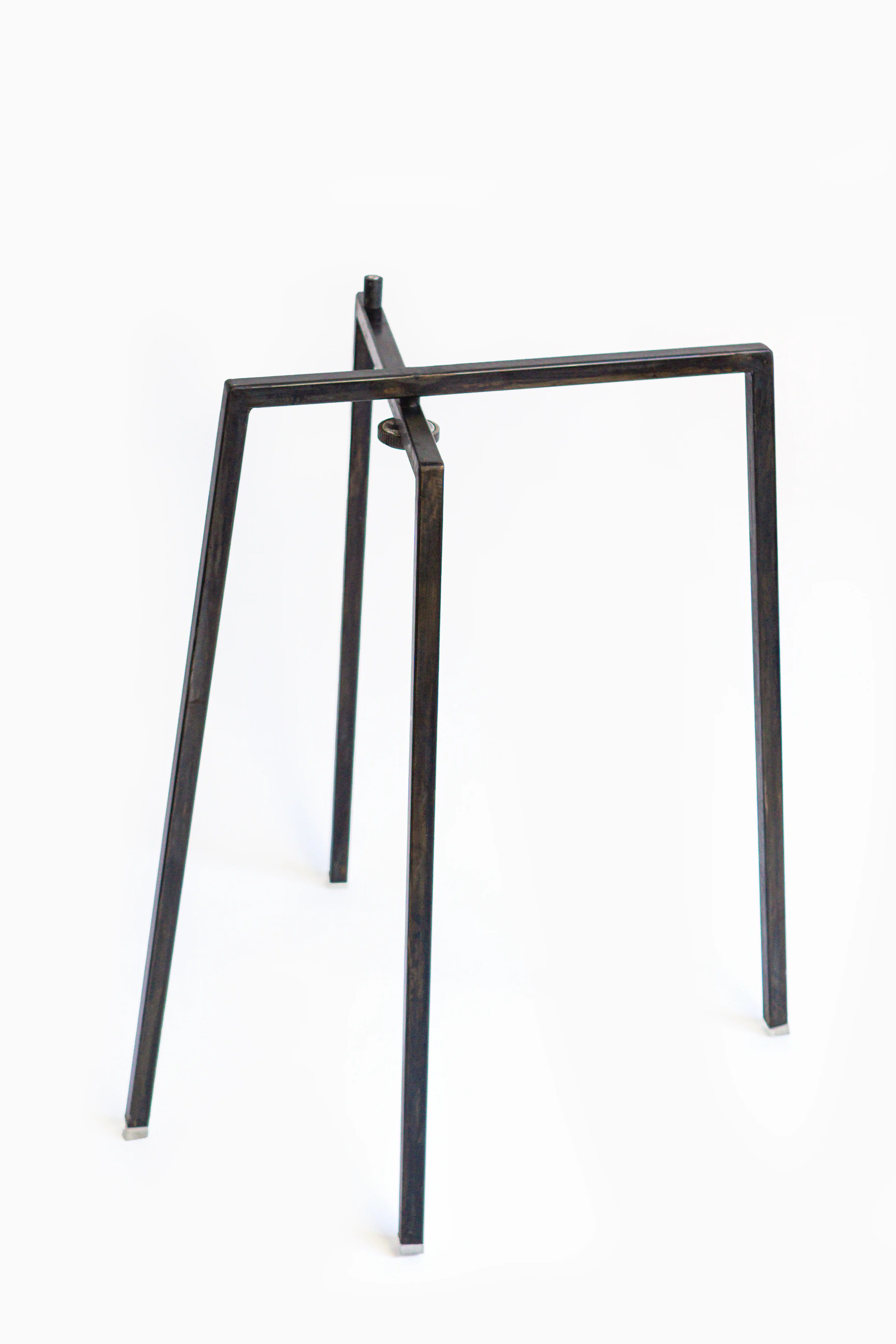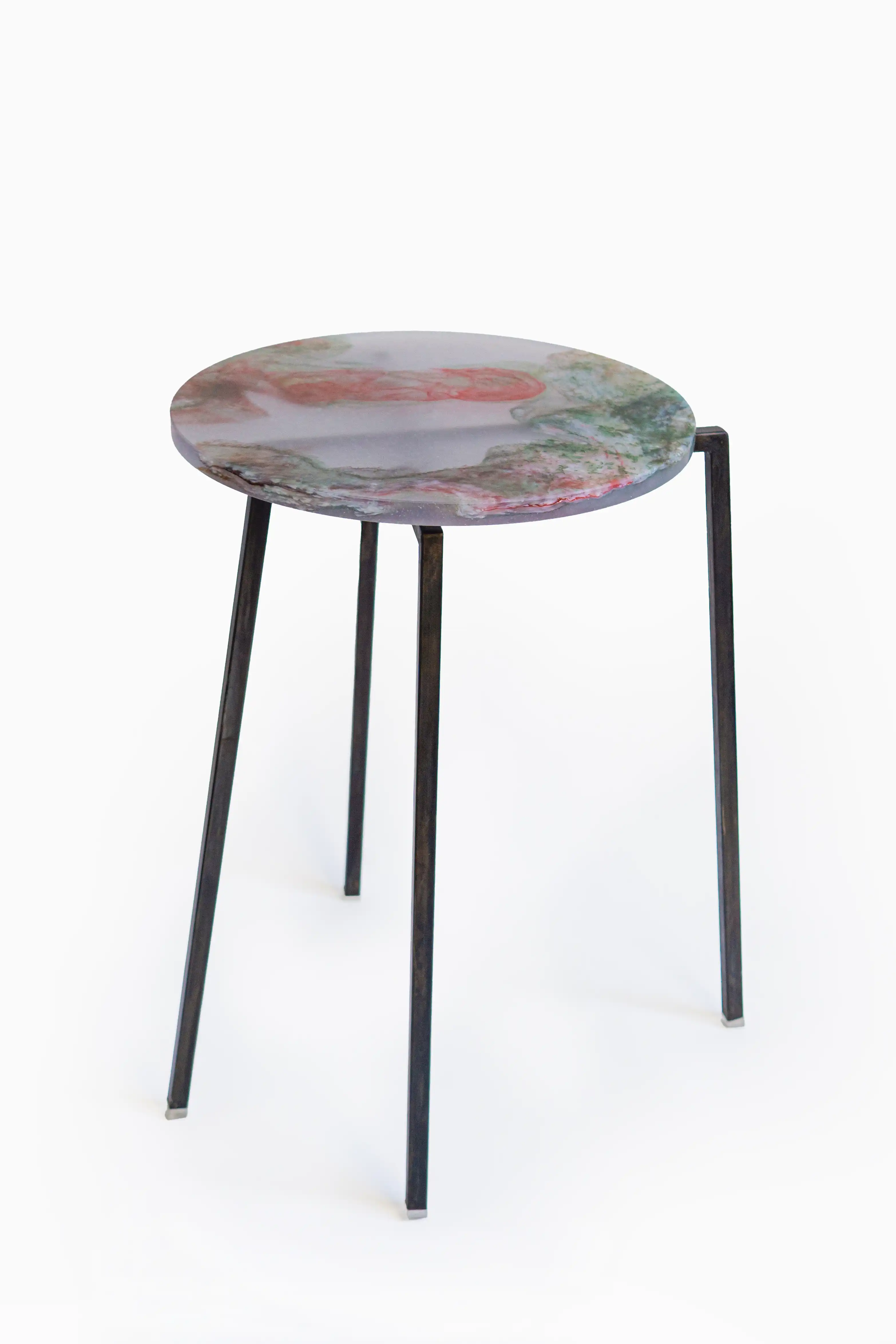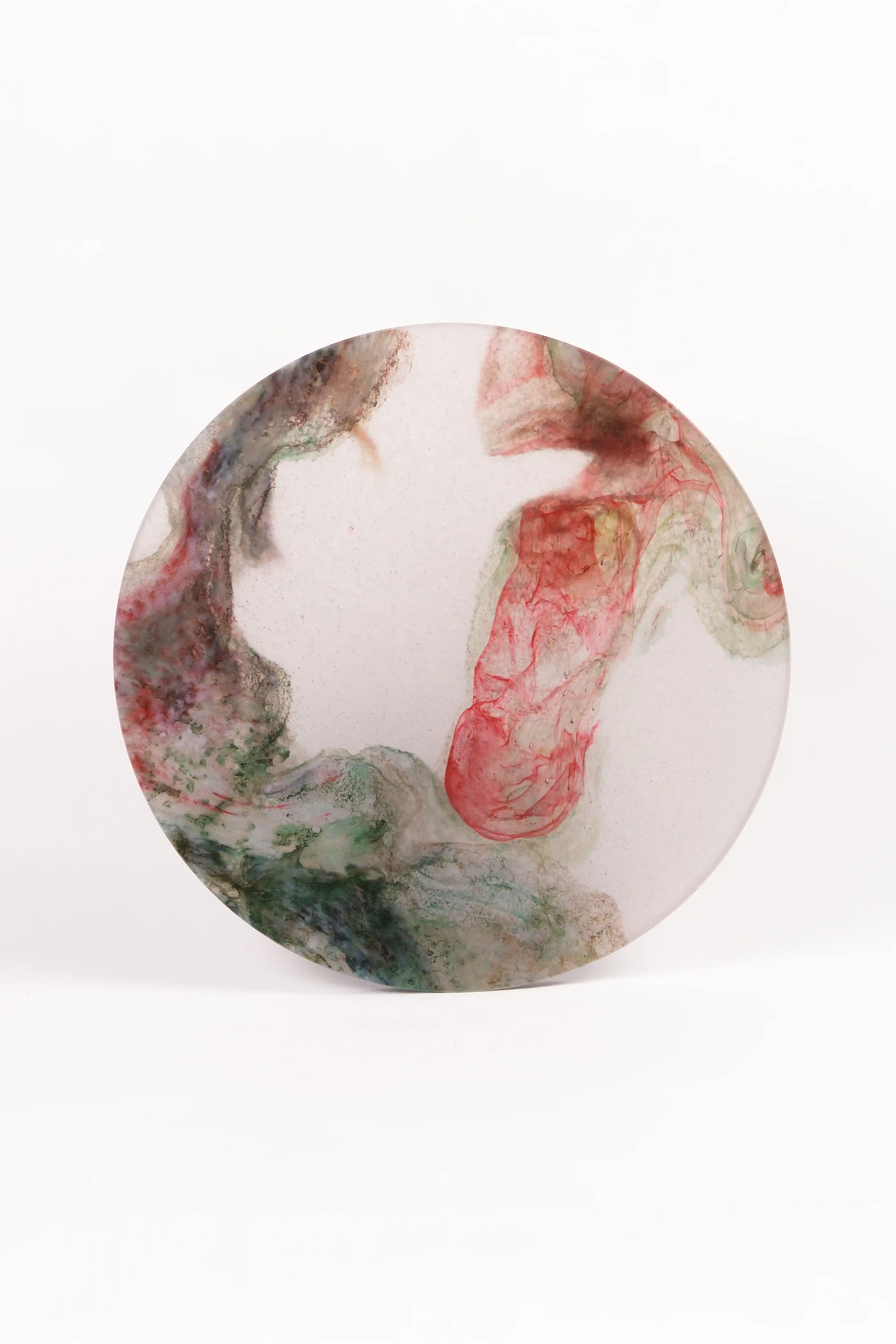My mother's older brother – my uncle – is a painter. He had been one long before I was born, but his being an artist didn't seem like important information to me until I was invited to his atelier for the first time as a young teenager.
I remember delicate sheets of cotton layered on tissue paper to prevent each from touching the next, all piled up on a big central table. Endless amounts of already stretched canvases faced the walls, though I don't think I ever knew what color those walls were actually painted, in my memory the boundaries of the room were defined by the sheer volume of objects placed around. The table was untidily covered with all sorts of crayons, watercolors, oil paints, drawings, sketches and tools of all kinds – again making it impossible to tell how big it really was. A pungent smell of turpentine wrapped the whole room, much like how incense does to certain churches.
I enter Clément's atelier in WUK and I am immediately thrown back to that first visit of my uncle's atelier. I have seen Clément working with Julian and Raphael in our FANTOPLAST workspace countless times since February, but stepping into his creative sanctuary is a very new and special experience for me, even though I have been to the space on occasion before.
Clément Bedel is the artist behind this year's FANTOPLAST Artist Edition—a series of tables created in collaboration with Lucas Schmid. The collection will be showcased for the first time at the Vienna Design Week (26.09 – 05.10.2025), with all pieces available for purchase at the dedicated FANTOPLAST's website.
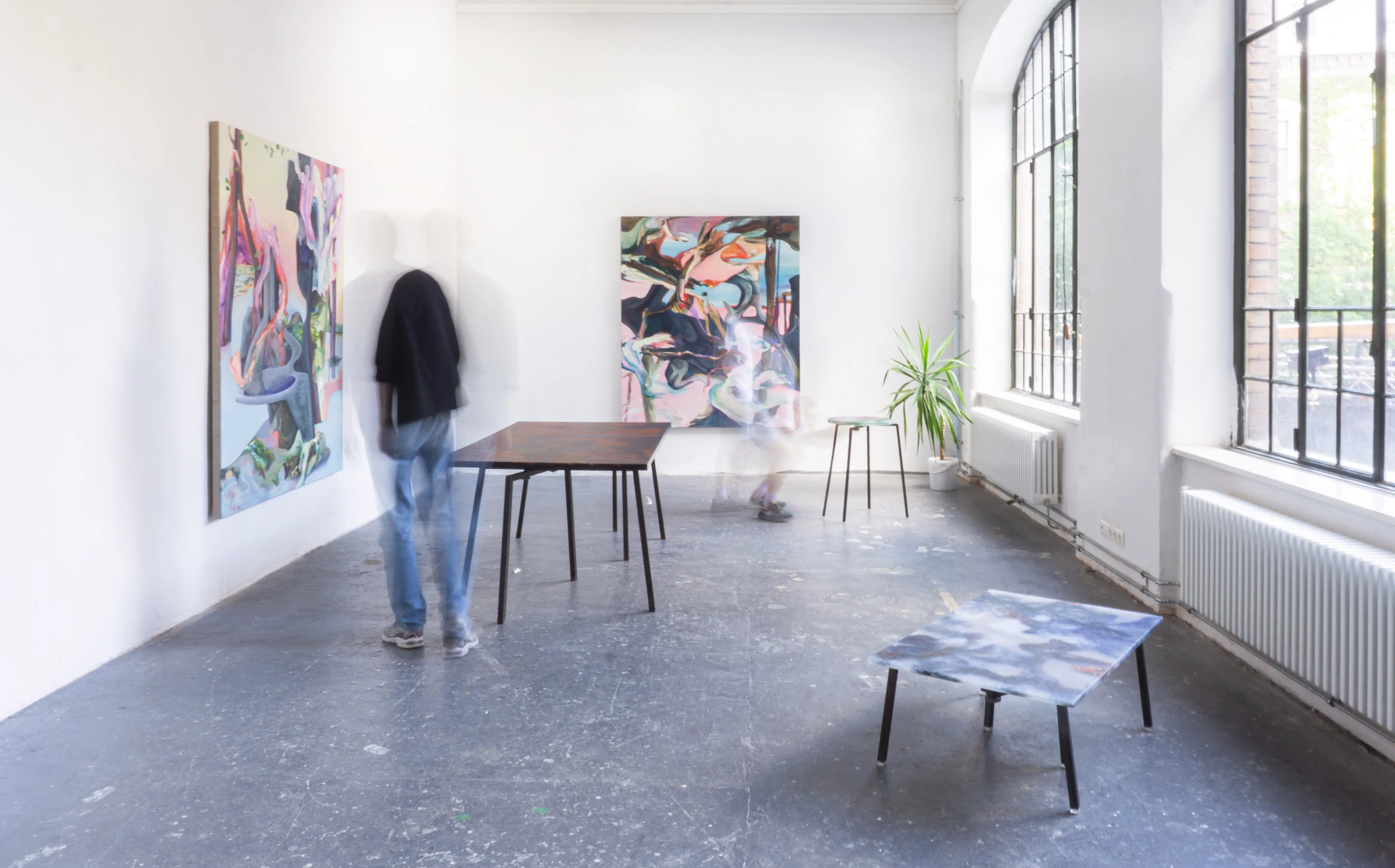
This conversation has been edited and condensed for length and clarity.
Hey Clément, could you tell us a little bit about your background?
Against all clichés for a French person, I'm not from Paris! I grew up in the Northeast of France, in a very rural region. There is this thing that we call "la diagonale du vide", the diagonal of emptiness, which is a beautiful extended area that's very remote and not densely populated. I think it shaped me in many ways because it's nestled in the mountains, with beautiful natural lakes, forests—everything. Growing up, there wasn't much to do besides enjoy this natural richness—it's like a "cultural desert," as we call it—but the connection with wildlife and nature was really important for me. I stayed there until I went to study art in Nancy, a medium-sized city closest to where I grew up, famous for Art Nouveau and such. I was there for a few years, and then I moved to Belgrade, Serbia, which was the first very big change for me.
Were you already training in painting in Nancy?
The school I attended had a very conceptual approach to most disciplines. I didn't really learn much about basic skills, craft and use of materials in the course I was enrolled in. I focused on video performances, installations, and digital art. At some point, I became frustrated with my lack of technical capacity—I didn't know how to create anything with my hands—which is why I chose to go to Belgrade. Unlike many artists, I wasn't a child who spent their time drawing or painting; painting came to me quite late and somewhat unexpectedly. Belgrade represented a significant change for me because my English wasn't very good at the time. Having always lived in smaller French places, I suddenly found myself in a completely different culture and country. This experience shaped me tremendously as a person first, and then as an artist, gradually drawing me into painting daily.
Did painting “come to you” as a result of your search for a medium that would feel more specifically yours?
Yes, but somehow I didn't question it that much. I was lacking something, but I wasn't really envisioning any specific medium. I thought I would continue with video and similar work. However, while at the Faculty of Fine Arts in Belgrade, there wasn't any equipment for recordings or videos. So I simply ended up doing what the other students were doing—drawing and painting models all day, every day. It became a routine I didn't really question, and I got excited very quickly. Starting from zero, I felt like I was improving significantly with each session and enjoying it more and more. Then something just clicked, and I never stopped, you know...
I wish I had the same dedication! That sounds a really nice way to fall in love with your artistic practice! What made you leave Belgrade and move to Vienna?
I stayed in Belgrade for almost five years and moved back to France right before COVID broke out—I felt it was time. I moved to Mulhouse for a couple of years, which is again a small city close to Switzerland and Germany, but I wanted to return to a bigger center. While considering where to go in Europe, I realized I liked the size of Belgrade, where there's enough happening that you always have things to do. Still, I didn't want to move to Paris or such a big city because painting requires a lot of alone time and energy. I wanted to stay focused on my work and not get too distracted in a major city.
I chose Vienna because of its position. I really love to travel by bus, so I thought, "okay, it's the center of Europe, I don't know it so well, let's do it." I also wanted to maintain my connection with Belgrade, and Vienna is quite close to the Balkans, which is one of my areas of research. I spoke a bit of German, and I thought it would be nice to improve it and be sort of in between places.
When you mentioned coming from this very rural area in France, I couldn't help but assume that this influence is still very present in your work today. When I look at your paintings, my eyes follow these abstract paths and imagine landscapes, though I wouldn't really call it "figurative," if that makes sense. I've also seen earlier work where these abstractions meet with something more—how would you say—realistic?
Actually, what you just said is a good starting point. When you talk about how you perceive my work now as abstract, I understand that's how this latest series is generally viewed, and I'm fine with that. However, I still consider it figuration. Even though there are fewer immediately recognizable elements in my latest paintings, the patterns and shape are still representing a mixture of elements found in nature. This question of representation is definitely a major point of evolution in my painting practice over the last years.
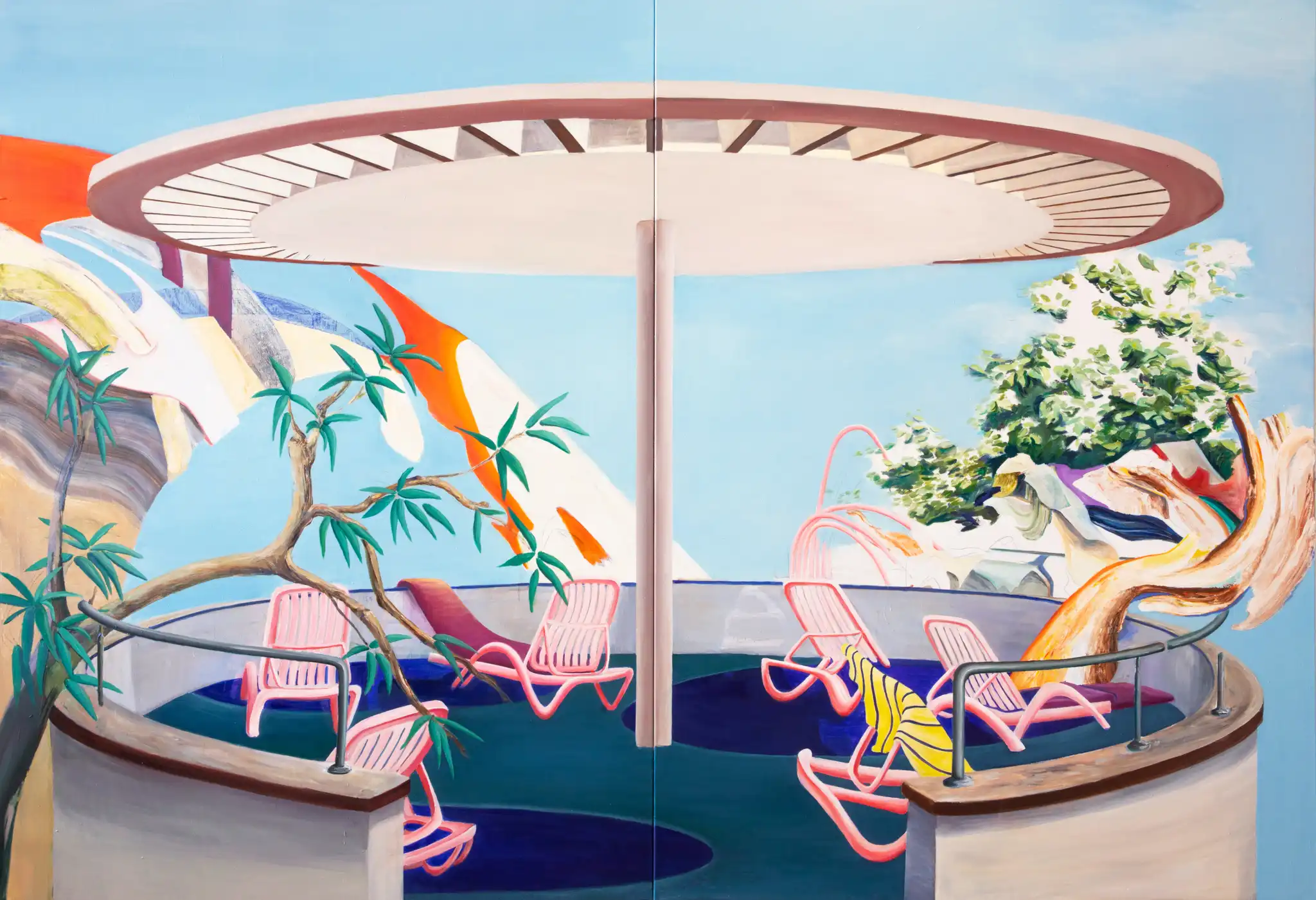
Now I'm more consciously interested in how shape and elements are constantly intertwined and not so much about the representation of isolated elements like tree, sky, leaf, anymore. I watch a lot of wildlife documentaries and I'm fascinated by biology—particularly how plants and animals interact and their defense mechanisms like aposematism or mimicry. For example, when an animal is threatened, it might change shape, alter its color, increase its size, or employ similar tactics. These shapeshifting movements deeply intrigue me. I'm drawn to natural phenomena that create strange effects, color explosions, and mixtures of elements—like the plastic continent and wastelands where nature and wildlife are reclaiming space. I blend all these visuals when I paint.
Are there non-visual references you regularly return to? Sources that inspire you and guide your work in certain directions?
Several writers and thinkers have been essential in helping me contextualize my work. Bruno Latour's critique of human exceptionalism, his Actor-Network Theory, and his emphasis on nonhumans have been particularly influential. Timothy Morton's concept of Hyperobjects is another theoretical work I frequently revisit. Morton explores things that are difficult to fully comprehend because they exist beyond our understanding of a clear, defined timeline—like plastic pollution or global warming.
In my paintings, I try to make these abstract ideas more tangible by creating visual maps of the changes our human imprint is causing: how pollutants merge with nature, how plants and creatures defend themselves, and what new forms emerge as a result. Everything blends into this environment, which I view as a figuration of existing realities, potential futures, and past events. This approach helps me break free from linear thinking and focus instead on the shape and raw materiality of our world. That's perhaps one aspect of my work, while the other connects deeply with painters I admire, primarily from the 20th century.
Do you ever think about your paintings that way? You know, asking yourself if the subjects of your paintings transcend your own idea of themselves and their “timeline”?
I wouldn't say the paintings themselves are hyperobjects, but some of the movements and elements could flow within this concept. I see every painting as unique, but I'm never working on just one painting at a time. I typically work on about 20 paintings simultaneously. Together, they form a complete body of work that I'm developing, and each piece serves as a kind of snippet or fragment of potential hyperobjects.
Have you always worked on canvas? You mentioned that you start with a quick drawing, which of course, is part of the sketching process—a way of bringing an idea to paper before moving forward. But has canvas always been your preferred medium for artistic expression?
I began working with many different media, and I still want to explore various art forms eventually. I've been thinking about creating sculptures for several years, but canvas has definitely been my primary medium. The way I approach canvas has evolved over time. As we discussed, I initially painted from a drawing perspective, trying to master techniques I hadn't learned before. However, this strong emphasis on drawing techniques was hindering what I wanted to achieve. I've now completely abandoned drawing, deliberately removing it from my practice. Today, I focus solely on shapes on canvas. This dialogue with the canvas is what I find most fulfilling, and it continually presents new challenges.
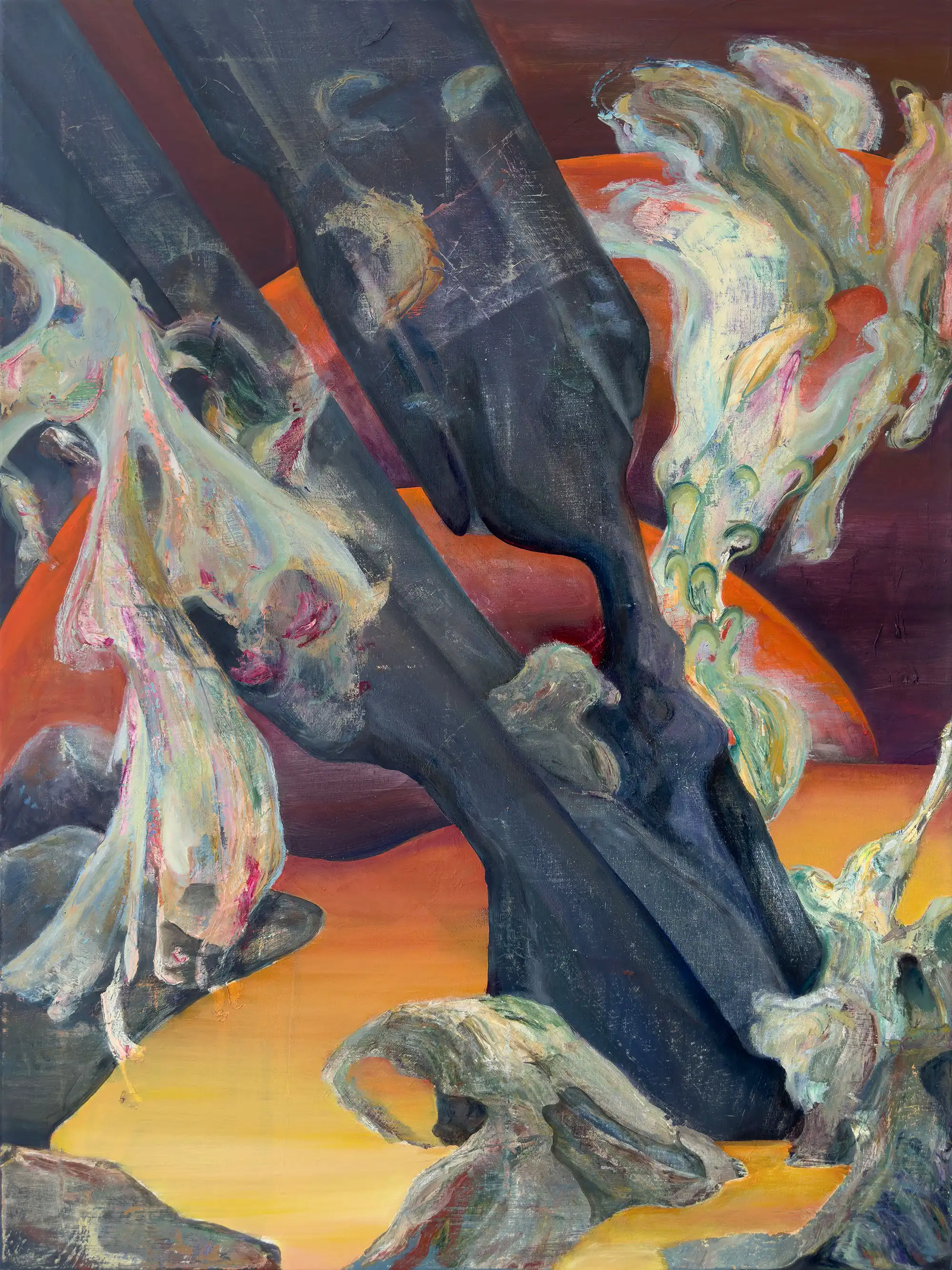
What brought you to apply to the FANTOPLAST open call for artists?
As I said, I've been thinking for some time of having painting as a main practice, but to start to open up to different things, like sculpture, to feed that back into my painting practice – to see it from different angles and new perspectives. When I heard about this open call, it was very interesting for me for different reasons. There was an interest in the plastic material itself, which I mentioned is in some ways also a "subject" of my work. I was curious to work with this material and also to experiment with pigments, because I felt I could apply my painting practice in a different way. I was really curious to see how these shapes would emerge and how different they would be from what I create on canvas. It was like a close cousin of what I'm doing, but with different rules since we would be working with flat surfaces that still do have some threedimensionality. I was also eager to work in a team again because painting is very solitary – I like that solitude and I need it, but once in a while group work can't hurt!
And how did it feel to approach this new kind of canvas? When you're working with plastic in this format or with these plates, the canvas and the painting on it essentially become the same thing, right?
Yes. It's not like you're painting over the canvas! It was actually quite... maybe relaxing isn't the right word... but it was really pleasant for me to work with very clear limits and boundaries linked to the material. With painting, I feel like I know the rules and then everything is possible within those boundaries. But with this plastic, you have many constraints related to how you need to press it and the timing. The format—everything—much of it is decided in advance and out of your control. So then you can only focus on one or two specific elements and put all your energy into those, which I thought was pretty cool.
I'm curious about how it felt to shift into this different mindset that isn't just about translating a concept or idea, but also making something functional. This seems like one of the biggest perceived differences between design and art—if we want to separate them drastically. You can certainly be artistic when doing design, but it also means you have a practical goal focused on functionality. Things need to work. If you design a table, it needs to accommodate a certain number of people and be the right height and so on. So there are many elements that go beyond what might be conceptually interesting. How did you approach these more practical aspects?
You know, it's actually funny that you ask this because I'm quite happy and weirdly proud to dedicate my life to something absolutely useless.
(Both are lost in laughter for a few seconds!)
I didn't say useful tough! I said functional!
Yes, exactly, but I love that my work doesn't have any practical use. That's something I really enjoy about it. Anyhow, to be honest, I didn't think about it that way—there was no switch in mindset for me because the practicality was already inherent in the making process. I mean, we didn't know exactly what size the pieces would be or their specific function when we started making them. But the functionality was so inherently connected to how we were building the plates that I wasn't consciously thinking about it. I knew it would become a functional object in the end—that was its purpose—but I wasn't really approaching it from that perspective.
In your concept proposal, you wrote that you wanted to experiment with color. You used raw pigments and mixed them with plastic granulates to make these plates. With painting, you have significant freedom in how color behaves, because you mix your own colors and they mostly remain stable throughout the process. But here, you had to embrace uncertainty. When working more sculpturally, unlike clay, where you can blend different materials to achieve specific tones, this process offered less control over both color and form. You can shape this very hot bubble once it’s melt, but you can't really determine where the colors will end up. So my question is: how much did you have to compromise with your original vision?
That's a very interesting question because the research of color and shape is not really at the center of what I'm doing. In my early works, I had a very straightforward approach where I was painting a few elements that were working really well next to each other but still could be perceived as separated. Having this very controlled approach where I was like “okay this goes well with this and I'm gonna make this very conscious and tailored composition”. As I went on, I tried to disrupt that.
I don't think it was very conscious at the beginning, but I gradually made changes to that. I started working with many more layers—stacking them on top of each other, turning the painting, and trying to disorient myself. This helped me get rid of preconceptions and allow chance to become a more significant factor in my work. I was directing chance, but still letting it flow freely. Recently, I've begun sanding my surfaces, which creates fascinating results where chance takes on even greater importance. Since I work with multiple layers—five or six typically—when I start sanding the surface, even on paintings that are years old, I never know what's underneath and feel almost like an archeologist, its incredibly exciting.
Then you work with this newfound material and hard surface, in a way. I find that fascinating. The plate-making process was similar in that you have some control with the pigments and how you make it, but because it all goes through distortion and heating, you can only control so much. I really saw parallels with what I'm doing in the studio where I'm trying to work more with intuition. I'm trying to get rid of this idea of fully controlling composition and instead working with chance and raw materials, trying to gently redirect them. Not having a hard, frontal approach to decision-making, but letting the material speak and creating a real communication where I let the thing speak for itself. It's about finding a middle ground between my intentions and what the plastic wants to do.
For what I have witnessed in the workspace, you were really open to listen to what the material was telling you in the moment. Was it challenging to leave behind the contemplative element, which was completely absent during the plastic plating process since you only had a few seconds to shape something with no opportunity to revise?
I actually still found some parallels to how I paint. When I paint – most of the time – I sit in front of the canvas and try to imagine what could solve it, and then the actual action is usually quite quick. With this plate making, it was also about mental preparation – thinking, "Okay, I'm going to have this burning, transparent blob, what am I going to do with it?" There was a lot of pre-thinking and preparation, trying to have an idea of where I wanted to go. And then the process takes the wheel, as we said, because you can only prepare so much. It becomes this quick action where you let intuition guide you, but there's also a lot you cannot control. In that way, it was quite nice.
Could you explain a bit about the process? In very practical terms, how did it all come together? I realize that while I know how the panels came to life, it might not be intuitive for someone unfamiliar with what has happened these past months!
I was selected, I believe, because of my idea to mix plastic with pigments. The team members were also interested in this approach since they typically work with a limited set of colors. We all felt it was a novel concept and quite exciting to try. Much of the early process involved figuring out how to actually do it. In that sense, it was a very artistic approach for everyone involved—the team using their technical skills and knowledge of the materials and machines, while I brought an outside perspective and ideas. Together, we went through extensive experimentation. I think the most interesting part of the process was the trial and error of mixing pigments with plastic—discovering how to make it visually interesting and how to integrate everything. Eventually, we developed a unique solution that produced fascinating results. We came up with the idea of first melting granulate batches at around 200 degrees, bringing them almost to a dough consistency, and then using heat-resistant gloves to mix in the pigments—similar to working with clay. Once cooled, the challenge became how to connect these pieces and arrange them on the metal form as a composition before returning to the regular panel-making process.
This year's Artist Edition bears your name. After producing the surfaces, we collectively decided to create table tops in various formats. At this point, another key figure entered the project—Lucas Schmid, an artist with expertise in wood and metal works. He designed the frames for these tables. How did you feel about his contribution? Do you think the frames complement and reinforce the concept behind your patterns? Are you satisfied with how they came together as finished objects?
Yes, I think the process wasn't clearly defined at the beginning—we didn't know exactly what would happen or how significant the project would become. We were working with many uncertainties around this pigment technique that none of us had used before. There was real doubt about whether any of us would be satisfied with the result. We considered it might just be a minor artist edition that we'd wrap up simply. But I think all of us were pretty surprised and excited by the outcome. I really felt the plates we created were unique and had a lot of depth, and I think you all agreed. And so then it became a different sort of discussion about how to create a proper, high-end unique design object and take it to the next level…
Take it “beyond the canvas”…
Yeah, to really push its potential. We had extensive group discussions about what would best complement the plates. Lucas's name emerged during this process, and after several conversations with him, we collectively decided on the direction. What we have now reflects that collaboration. We chose to work with metal as a complementary material to achieve this somewhat industrial aesthetic. I'm really happy about the result. Lucas did a great job listening to our needs, even though I wasn't necessarily knowing how to articulate them since I'm not a designer. I have a very specific set of skills, and it was really nice to hear his perspective. I felt like he really understood what our goal was with this table and where we wanted to go. He managed to make something tailor-made and unique for us. I think the elements complement each other really nicely. It has a unique, somewhat playful approach.
The shapes and patterns that emerged in those plates have a very earthly, mineral-like aesthetic. They remind me of stones, though with a certain softness that comes from the haptic quality—plastic isn't as cold to the touch as stone.
That's why I think we were also excited about them. It was really unexpected for me that they would look so close to these feelings, you know? Each one is like a world in itself. The dark ones have this volcano vibe, while the light ones have this icy, earthly texture. I feel they all connect to what I was saying about nature and objects—these things that don't have a figurative shape but evoke emotions and feelings deeply connected to the natural world. What's also interesting is the fact that it's plastic, right? Yet you feel so strongly about the natural elements, as if you were seeing pieces of Earth from space. And it's plastic, which I think is really fantastic and something I truly appreciate.
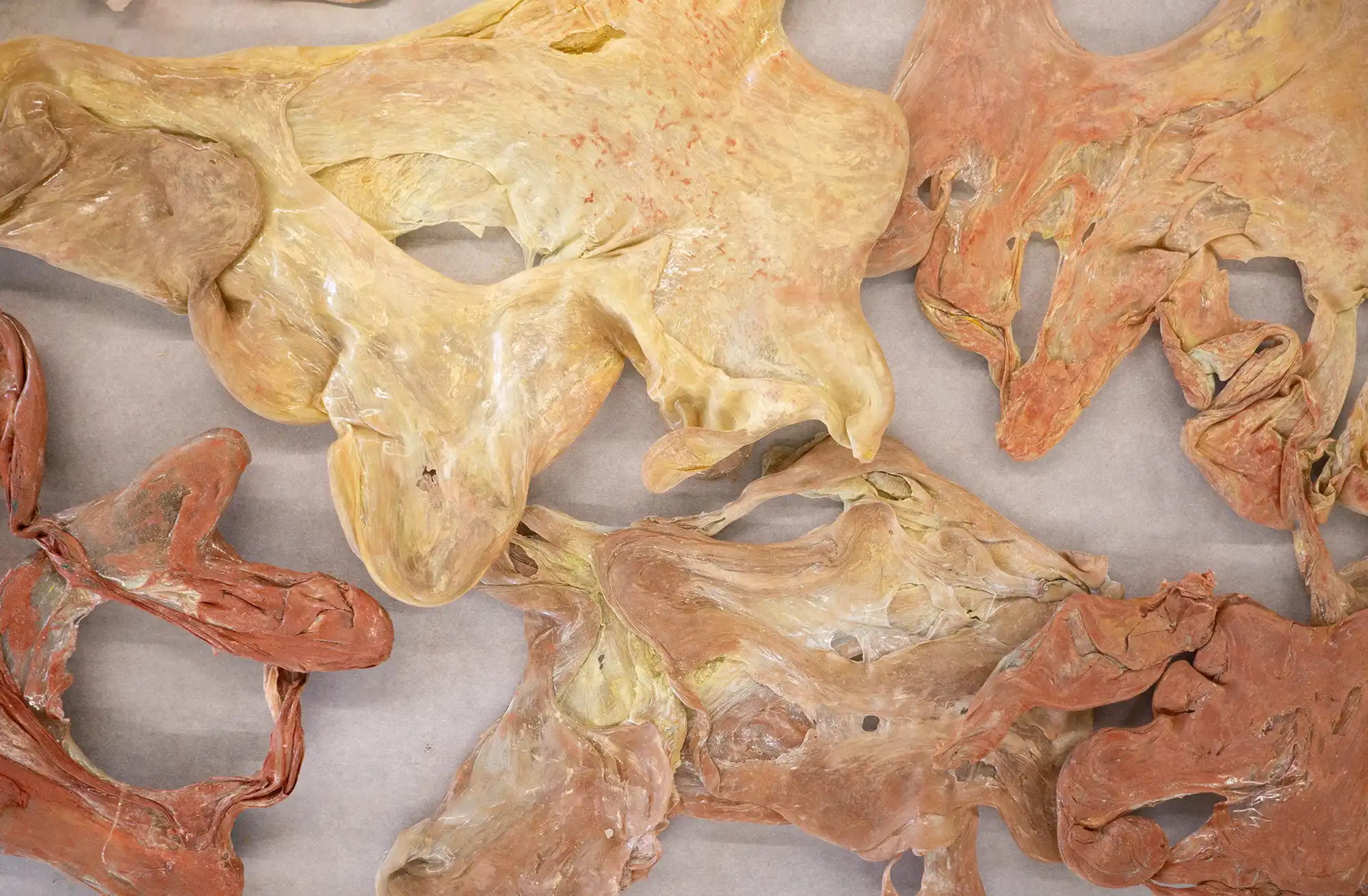
It connects really well with what you mentioned at the beginning—how your research explores the intersection between human-made elements and nature, and how they intertwine and compete for space. I mean space in the literal sense—what exists in the physical world.
Yes, exactly—it's about moving away from a human-centered approach. Instead, I see things as an intertwining of many different elements—living and non-living beings and objects all meshed together within a rectangular format, which is actually the common point between these plates and my paintings.
I think it's a nice tension that you managed to freeze in there!
We will present for the first time the Artist Edition at the Vienna Design Week, which will open on September 26. The whole series consists of 28 pieces, altogether, I think that there are like around 20 small cocktail tables, there are a few rectangular pieces and "the big guy". Next to it, there will be showcased two of your big format paintings. Why did you decide to pick those two and what's their story if they have one?
It was interesting because these two paintings fit very well with what we were trying to do spatially at the design week in different ways. First, they're paintings I finished right before starting this artist edition with you at FANTOPLAST. That was my starting point when I began thinking about the project and how to use pigments. So it was fascinating for me to put them in communication with the new work. Additionally, since we'll have a central exhibition space without walls, I liked the idea of having two same size paintings back-to-back, which allow visitors to experience different perspectives as they move around the installation.
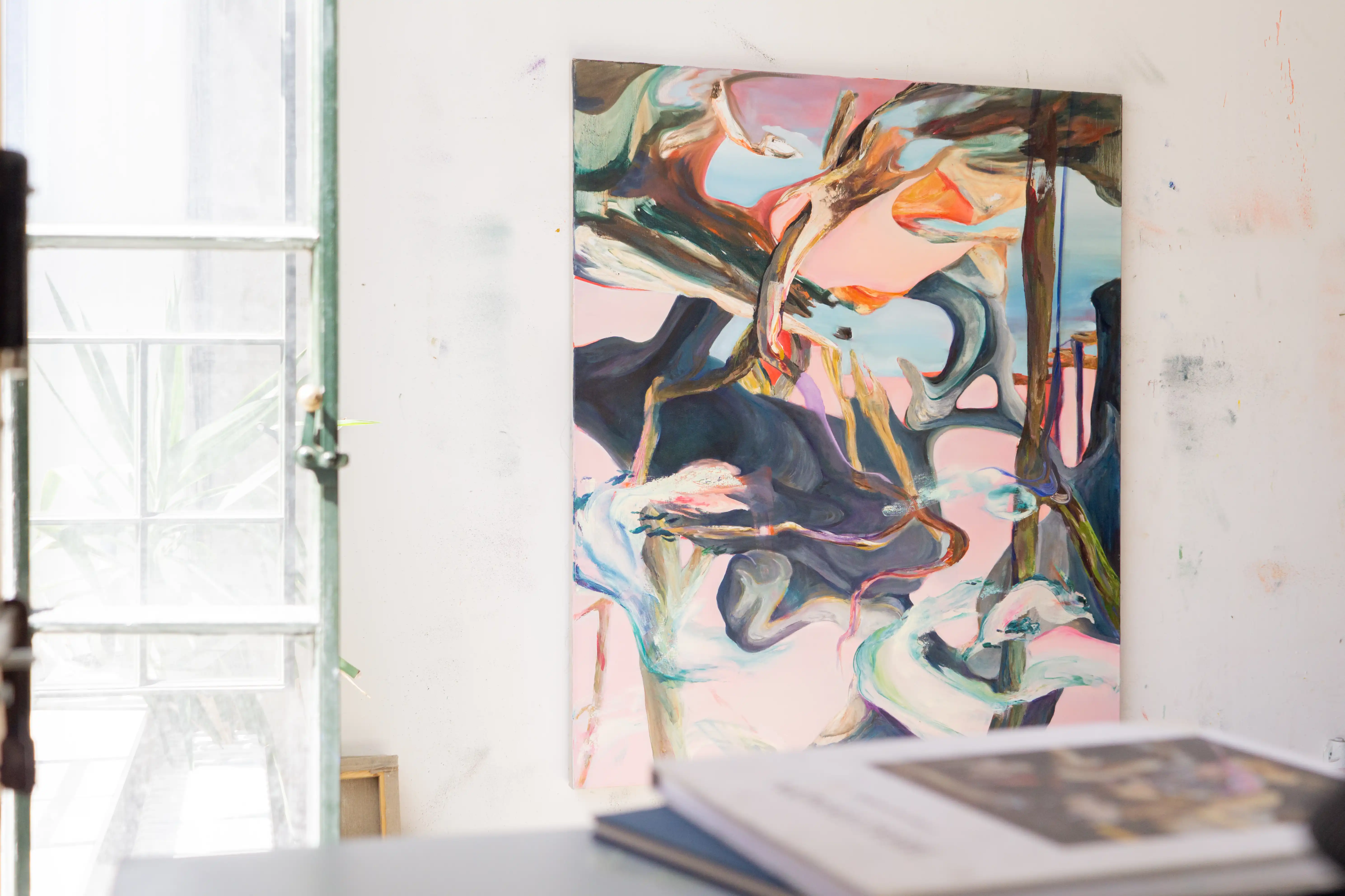
What's one thing you'd like to keep and one thing you'd like to discard from this experience of working with a new material and pursuing different outcomes? Perhaps something new or interesting that you've learned and want to incorporate into your practice?
I don't really consider myself someone who consciously decides what to keep or throw away. Especially with throwing things away—that's not typically my approach. I believe more in building meaningful experiences and letting things stay with me naturally. I think this group activity will work in the background, like an accumulation of experiences. It's difficult for me to pinpoint exactly what will stick.
The approach to these plastic blobs will definitely stay with me because it's so closely related to what I'm doing on canvas. I think it's going to influence my work—it's already making its way into my practice. I was quite surprised by some of the results we achieved. On a simpler note, I really enjoyed working as a group and would like to collaborate on specific projects again in the future.
Links
Complete Catalogue of the Artist Edition 2025 series:
www.artist-edition.fantoplast.com
BEYOND THE CANVAS
ARTIST EDITION 2025
at the Vienna Design Week
26.9.2025, 11am–8pm
27.9.2025, 11am–10pm
28.9.–5.10.2025, 11am–8pm
Festival Headquarters
4., Wiedner Hauptstraße 52
Cover Image: Clément Bedel – Embrace, oil on canvas, 190x280cm, 2025
